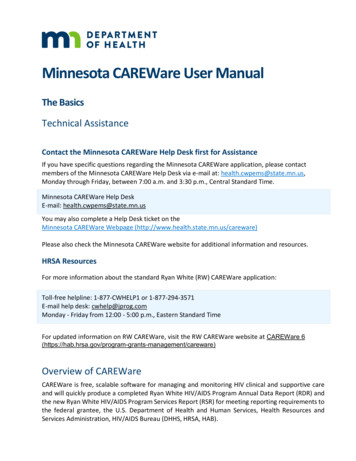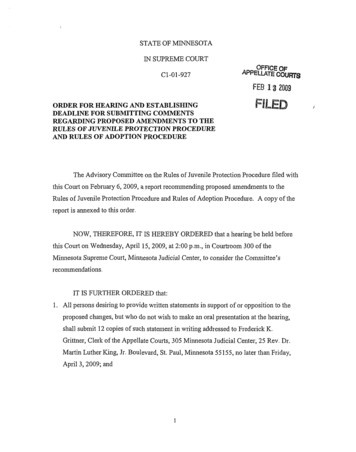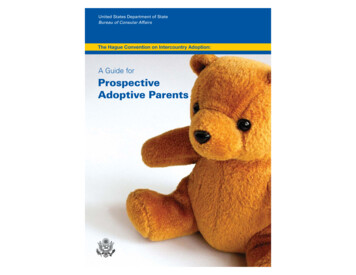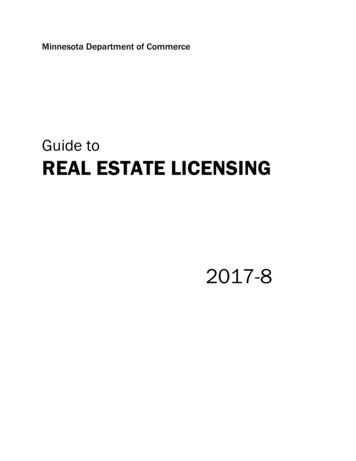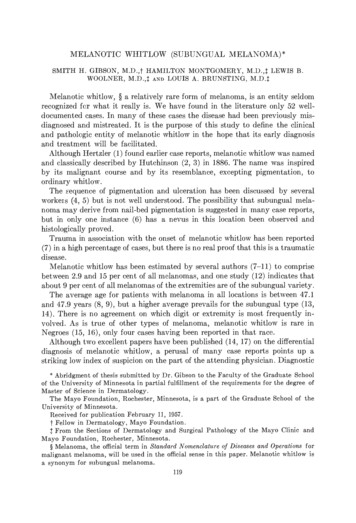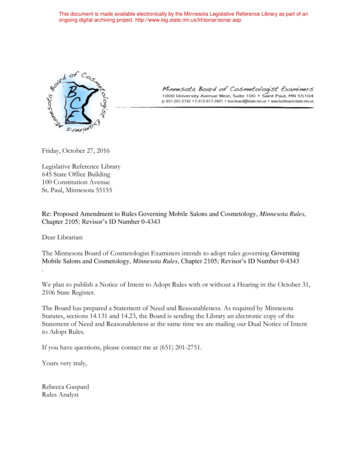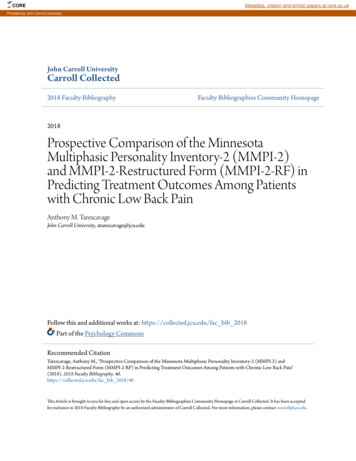
Transcription
COREMetadata, citation and similar papers at core.ac.ukProvided by John Carroll UniversityJohn Carroll UniversityCarroll Collected2018 Faculty BibliographyFaculty Bibliographies Community Homepage2018Prospective Comparison of the MinnesotaMultiphasic Personality Inventory-2 (MMPI-2)and MMPI-2-Restructured Form (MMPI-2-RF) inPredicting Treatment Outcomes Among Patientswith Chronic Low Back PainAnthony M. TarescavageJohn Carroll University, atarescavage@jcu.eduFollow this and additional works at: https://collected.jcu.edu/fac bib 2018Part of the Psychology CommonsRecommended CitationTarescavage, Anthony M., "Prospective Comparison of the Minnesota Multiphasic Personality Inventory-2 (MMPI-2) andMMPI-2-Restructured Form (MMPI-2-RF) in Predicting Treatment Outcomes Among Patients with Chronic Low Back Pain"(2018). 2018 Faculty Bibliography. 40.https://collected.jcu.edu/fac bib 2018/40This Article is brought to you for free and open access by the Faculty Bibliographies Community Homepage at Carroll Collected. It has been acceptedfor inclusion in 2018 Faculty Bibliography by an authorized administrator of Carroll Collected. For more information, please contact connell@jcu.edu.
Prospective Comparison of the Minnesota Multiphasic PersonalityInventory-2 (MMPI-2) and MMPI-2-Restructured Form (MMPI-2-RF)in Predicting Treatment Outcomes Among Patients with Chronic LowBack PainAnthony M. Tarescavage1 · Judith Scheman2 · Yossef S. Ben‑Porath3AbstractThe purpose of the current study was to examine the relative utility of the most updated MMPI adult instrument, the Minnesota Multiphasic Personality Inventory-2-Restructured Form (MMPI-2-RF), which was designed to addresspsychometric limitations of the MMPI-2. To this end, we compared mean scores and correlates of emotional distresstreatment outcomes using the Depression Anxiety Stress Scales in a sample of 230 patients (73 males, 157 females) whohad completed an inter-disciplinary chronic pain rehabilitation program. Structural equation modeling analyses indicatedthat higher scale scores from all the MMPI-2-RF substantive domains were meaningfully associated with worse emotionaldistress outcomes, whereas the MMPI-2 Clinical Scales generally did not have any meaningful associations. Similarresults were found in additional analyses using a clinically significant change framework with more direct clinicalimplications. The results of this study provide preliminary support for the use of the MMPI-2-RF among patients withchronic low back pain.Keywords MMPI-2-RF · Chronic pain · Back pain · Treatment outcome · Applied assessmentIntroductionChronic low back pain has a considerable impact on society.The prevalence of the disorder is rising (Freburger et al.,2009; Rubin, 2007), which is a prominent cause of disability(McNeil & Binette, 2001) and sick days (LaBar, 1992), andit has substantial economic influence (Guo, Tanaka, Halperin, & Cameron, 1999; Katz, 2006). Moreover, it is associated with psychological problems, as the 12-month prevalence rates of mood and anxiety disorders in this populationare 17.5 and 26.5% (Von Korff et al., 2005), respectively,* Anthony M. Tarescavageatarescavage@jcu.edu1Department of Psychological Sciences, John CarrollUniversity, 1 John Carroll Boulevard, University Heights,OH 44118, USA2Digestive Disease and Surgical Institute, Cleveland ClinicFoundation, 9500 Euclic Avenue, Cleveland, OH 44195,USA3Department of Psychological Sciences, Kent State University,144 Kent Hall, Kent, OH 44242, USAwhich are nearly double the general population prevalencerates (Kessler et al., 2004). Chronic pain is also associatedwith the increased rates of illicit drug use, particularly opioid abuse (Manchikanti et al., 2006).According to the biopsychosocial perspective of pain(Gatchel, McGeary, McGeary, & Lippe, 2014; Gatchel,Peng, Peters, Fuchs, & Turk, 2007), biological, psychological, and social factors interact to influence the experience ofpain. Gatchel et al. (2007) provide an overview of how thesefactors affect the perception of illness, noting that pertinentpsychological factors include mood problems, such as anxiety and depression, as well as cognitions that may lead topain catastrophizing. The American College of Physiciansand the American Pain Society recommend interdisciplinarytreatment with an assessment of these and other psychosocial factors (Chou et al., 2007). They have been found to bestronger predictors of outcome than physical examinations,severity of pain, and duration of pain (Chou et al., 2007).Psychological testing is one way to assess for these factors, with the Minnesota Multiphasic Personality Inventory (MMPI) (Hathaway & McKinley, 1943) and MMPI-2(Butcher et al., 2001) historically having been the most
frequently used psychological tests among chronic painpatients (Piotrowski, 1998; Piotrowski & Lubin, 1990).However, use of these instruments began to decline inchronic pain settings in the mid-to-late-1990s. During thistime, a series of articles debating the utility of the instrumentwere published in Pain Forum. Main and Spanswick (1995)began the debate with an article entitled “Personality Assessment and the Minnesota Multiphasic Personality Inventory:50 years on: Do we still need our security blanket?” Theauthors criticized the test for its psychometric shortcomings,writing, “Its inherent structural weaknesses undermine itsclinical validity, even when it does provide additional clinical information” (p. 92). They called for prospective chronicpain outcome studies using advanced quantitative analysessuch as structural equation modeling and measures “whichreflect the world of pain rather than promulgate the sort ofpsychoarcheology represented by the MMPI and MMPI-2”(p. 95). Most of these concerns were echoed by other authorsin the debate (Keefe, Lefebvre, & Beaupre, 1995; Turk &Fernandez, 1995). However, Bradley (1995) countered theseclaims by reviewing a series of research studies indicatingthat individuals can be reliably categorized into MMPI Scalescore subgroups, which demonstrate concurrent associationswith factors that may predict outcome (such as pain intensity, medication use, disability, and work status). Overall,most of the authors in the series agreed that significantproblems with the test’s Clinical Scales (which were nearlyidentical to the MMPI’s Clinical Scales) limited the test’sutility in this setting.Several years after the debate, the MMPI-2-RestructuredForm (MMPI-2-RF; Ben-Porath & Tellegen, 2008/2011),was released as an updated version of the MMPI-2. TheMMPI-2-RF is a 338-item broadband measure of psychopathology with 51 scales. The nine Validity Scales ofthe test are designed to assess for problematic test-takingapproaches, which include random and acquiescent responding, as well as over- and underreporting of psychologicalproblems. The test’s substantive scales measure psychological constructs and are anchored by the nine RestructuredClinical (RC) Scales. The primary goal of the RC Scalesproject was to address the psychometric limitations of theClinical Scales by substantially reducing the scale overlapand heterogeneity that complicated their interpretation anduse in research, while still measuring the major distinctivecore constructs assessed by each scale. The constructs measured by the scales were also more clearly tied to modernpsychopathology models and constructs (Sellbom, BenPorath, & Bagby, 2008). These revisions address some ofthe primary concerns with the Clinical Scales advanced byauthors in the debate.The MMPI-2-RF test authors used similar modern scaledevelopment strategies for two substantive scale sets thatcomplement the RC Scales: (1) the three Higher-OrderScales that measure internalizing dysfunction, thought dysfunction, and externalizing dysfunction, broadly defined,and; (2) the 23 Specific Problems Scales that measure RCScale subdomains or other, more narrowly focused constructs that are related to, but distinct from those measuredby the RC Scales. Revised and improved versions of theMMPI-2 PSY-5 Scales, which measure broad domains ofabnormal personality, are also included on the test. Overall, the MMPI-2-RF measures five substantive domains ofpersonality and psychopathology: (1) Emotional Dysfunction; (2) Thought Dysfunction; (3) Behavioral/ExternalizingDysfunction; (4) Somatic/Cognitive Problems; and (5) Interpersonal Functioning (see Table 1 for scale descriptions).McCord and Drerup (2011) demonstrated the improvedinterpretive utility of the RC Scales in comparison to theClinical Scales in a chronic pain sample. These authors categorized 316 chronic pain patients into depressed and nondepressed diagnostic groups. The depression group includedindividuals diagnosed with major depression, dysthymia,and adjustment disorder, whereas the nondepressed groupwas not diagnosed with any form of mood disturbance. Theycompared mean scores on the Clinical and RC Scales acrossthe two groups. In the nondepressed group, mean ClinicalScale elevations (i.e., scores 65T) were found on scales1 (Hypochondriasis), 2 (Depression), 3 (Hysteria), and 8(Schizophrenia), whereas only RC1 (Somatic Complaints)produced a mean RC Scale elevation. In the depressedgroup, mean clinical elevations were observed for the following Clinical Scales: 1 (Hypochondriasis), 2 (Depression),3 (Hysteria), 4 (Psychopathic Deviate), 6 (Paranoia), 7 (Psychastenia), and 8 (Schizophrenia). The pattern of elevationswas consistent with the neurotic-triad cluster and code typetypically found in Clinical Scale research in this setting, withprominent elevations on scales 1, 2, and 3. In stark contrastto the Clinical Scale findings, mean RC scale elevations wereobserved in the depressed group for only RCd (Demoralization), RC1 (Somatic Complaints), and RC2 (Low PositiveEmotions), demonstrating substantially improved discriminant validity. McCord and Drerup (2011) summarize theimplications of the findings from the depressed group:“The clinician relying on the Clinical Scales would seeclinical-range elevations on all scales except Scale 9, withextreme elevations on Scales 1, 2, and 3 and troubling elevations on 7 and 8 as well. In contrast, the RC Scales indicatethree things: (a) a significant level of demoralization; (b)significant somatic complaints; and (c) depression. The latterset of data is far more consistent with the clinical diagnosesin the patient charts” (p. 145).Current StudyDespite the substantial psychometric and interpretiveimprovements compared to the Clinical Scales, no study has
68Table 1 Minnesota Multiphasic Personality Inventory-2-Restructured Form ScalesValidity ScalesInconsistent BSUnderreportingL-rK-rHigher-Order (H-O) ScalesEIDTHDBXDRestructured Clinical (RC) ScalesRCdRC1RC2RC3RC4RC6RC7RC8RC9Specific Problem (SP) ScalesSomatic/Cognitive ScalesMLSGICHPCNUCCOGInternalizing ScalesSUIHLPSFDNFCSTWAXYANPBRFMSFExternalizing ScalesJCPSUBAGG ACT Variable response inconsistency-random respondingTrue response inconsistency-fixed respondingInfrequent responses—responses infrequent in the general populationInfrequent psychopathology responses—responses infrequent in psychiatric populationsInfrequent somatic responses—somatic complaints infrequent in medical patient populationsSymptom validity—somatic and cognitive complaints associated at high levels with overreportingResponse bias scale—exaggerated memory complaintsUncommon virtues—rarely claimed moral attributes or activitiesAdjustment validity—avowals of good psychological adjustment associated at high levels with underreportingEmotional/internalizing dysfunction—problems associated with mood and affectThought dysfunction—problems associated with disordered thinkingBehavioral/externalizing dysfunction—problems associated with under-controlled behaviorDemoralization—general unhappiness and dissatisfactionSomatic complaints—diffuse physical health complaintsLow positive emotions—lack of positive emotional responsivenessCynicism—non-self-referential beliefs expressing distrust and a generally low opinion of othersAntisocial behavior—rule breaking and irresponsible behaviorIdeas of persecution—self-referential beliefs that others pose a threatDysfunctional negative emotions—maladaptive anxiety, anger, and irritabilityAberrant experiences—unusual perceptions or thoughtsHypomanic activation—overactivation, aggression, impulsivity, and grandiosityMalaise—overall sense of physical debilitation, poor healthGastrointestinal complaints—nausea, recurring upset stomach, and poor appetiteHead pain complaints—head and neck painNeurological complaints—dizziness, weakness, paralysis, loss of balance, etcCognitive complaints—memory problems, difficulties concentratingSuicidal/death ideation—direct reports of suicidal ideation and recent suicide attemptsHelplessness/hopelessness—belief that goals cannot be reached or problems solvedSelf-doubt—lack of confidence, feelings of uselessnessInefficacy—belief that one is indecisive and inefficaciousStress/worry—preoccupation with disappointments, difficulty with time pressureAnxiety—pervasive anxiety, frights, frequent nightmaresAnger proneness—becoming easily angered, impatient with othersBehavior-restricting fears—fears that significantly inhibit normal activitiesMultiple specific fears—fears of blood, fire, thunder, etcJuvenile conduct problems—difficulties at school and at home, stealingSubstance abuse—current and past misuse of alcohol and drugsAggression—physically aggressive, violent behaviorActivation—heightened excitation and energy level
Table 1 (continued)Interpersonal ScalesFMLFamily problems—conflictual family relationshipsIPPInterpersonal passivity—being unassertive and submissiveSAVSocial avoidance—avoiding or not enjoying social eventsSHYShyness—bashful, prone to feel inhibited and anxious around othersDSFDisaffiliativeness—disliking people and being around themInterest ScalesAESAesthetic-literary interests—literature, music, the theaterMECMechanical–physical interests—fixing and building things, the outdoors, sportsPersonality Psychopathology Five (PSY-5) ScalesAGGR-rAggressiveness-revised—instrumental, goal directed on from led behaviorNEGE-rNegative emotionality/neuroticism-revised—anxiety, insecurity, worry, and fearINTR-rIntroversion/low positive emotionality-revised—social disengagement and anhedoniaFrom MMPI-2-RF Manual for Administration, Scoring, and Interpretation by Yossef S. BenPorath and Auke Tellegen. Copyright 2008, 2011by the Regents of the University of Minnesota. Reproduced by permission of the University of Minnesota Press. All rights reserved. “MinnesotaMultiphasic Personality Inventory-2-RF ” and “MMPI-2-RF ” are trademarks owned by the Regents of the University of Minnesotainvestigated use of the RC Scales to predict outcomes amongchronic pain patients undergoing conventional conservativetreatments. The purpose of the current study was to investigate the ability of the MMPI-2-RF to predict self-reportedemotional distress outcomes among patients with chroniclow back pain completing short-term interdisciplinary rehabilitation treatment. Because this is the first comprehensiveinvestigation of the revised inventory, rather than test-specific hypotheses, in the context of discovery (Reichenbach,1938), we investigated the association between all MMPI2-RF scale scores with emotional distress outcomes (asmeasured by the Depression Anxiety Stress Scales) (Lovibond & Lovibond, 1995) after controlling for age and gender, as well as pain intensity and duration of pain. In linewith suggestions by Main and Spanswick (1995), we examined these associations using structural equation modeling.Finally, we compared the scores of interpretive utility andthe predictive capacity of the MMPI-2-RF scales and theMMPI-2 Clinical Scales, and we expected that the MMPI2-RF scales would demonstrate substantially greater interpretive utility and larger effect sizes in predicting outcomegiven its structural and theoretical improvements.administered the MMPI-2 as well as the Depression Anxiety Stress Scales (DASS) at intake. Overall, 249 (89.6%) ofthese individuals were eligible for inclusion because theycompleted the program and were administered the DASSat discharge. Completers participated in the program for anaverage of 20.6 days (SD 6.8).MMPI-2 items were used to calculate MMPI-2-RF scalescores, which is possible because all 338 MMPI-2-RFitems are included in the MMPI-2 booklet. Past researchhas demonstrated the relative comparability of MMPI-2-RFscale scores generated from both booklets (Tellegen & BenPorath, 2008/2011; Van der Heijden, Egger, & Derksen,2010). An additional 19 participants were excluded from theanalyses because they produced invalid MMPI-2-RF profilesaccording to the test authors’ published guidelines, whichincluded cannot say, CNS Raw score 18; variable responseinconsistency, VRIN-r 80; true response inconsistency,TRIN-r 80; infrequent responding, F-r 120; and infrequent psychopathology responses, Fp-r 100 (Ben-Porath& Tellegen, 2008/2011).The final sample included 230 patients (73 males, 157females) after exclusions.1 The majority of the sample wasmarried (62.6%) and other martial statuses included neverMethodsParticipantsParticipants were drawn from an archival sample of 278 nonconsecutive chronic pain patients (93 males, 185 females)who presented with lower back pain to a 3–4 week interdisciplinary pain treatment program in Northeast Ohio and were1There were a total of 14 additional participants (6% of sample) whowould have been excluded from the study if we removed individualswith elevated scores ( 100T) on Fs, FBS-r, or RBS. According toBen-Porath and Tellegen (2008/2011), elevated scores on these threevalidity scales suggest scores on the Somatic/Cognitive scales maybe invalid. We ran the study analyses after excluding these 14 individuals, and the interpretation of the findings did not meaningfullychange.
70married (19.6%), divorced (10.0%), widowed (3.0%), andseparated (1.3%). The average age was 46.5 (SD 14.5),and the average years of education was 14.3 (SD 3.1).No significant differences were observed on most demographic variables between the excluded individuals andthe final sample (p’s .23). However, excluded individuals were more likely to have a marital status of separated,χ2(5) 11.455, p .043, Std. residual 2.6. In the finalsample, the most common DSM-IV-TR (American Psychiatric Association, 2000) diagnoses included major depressive disorder (48.8%), a substance use disorder (36.3%),an anxiety disorder (18.2%), a bipolar disorder (4.9%),post-traumatic stress disorder (2.6%), or a somatizationdisorder (0.9%)(categories are not mutually exclusive). Tosome extent, these rates may underestimate comorbid psychopathology because billing was not based the presenceof a mental disorder. Common comorbid medical conditions included joint pain (44.8%), neck pain (38.7%), footpain (29.1%), fibromyalgia (25.8%), migraine (19.7%),arthritis (18.3%), neuropathic pain (17.8%), abdominalpain (10.4%), myofascial pain (5.7%), chronic regionalpain syndrome (5.2%), chronic fatigue syndrome (3.9%),tension headache (3.5%), dizziness (3.1%), and diabetes(3.1%). In terms of medications at intake, 67.6% were prescribed an antidepressant and 61.9% were prescribed painmedications.MeasuresMMPI‑2‑RFThe MMPI-2-RF is described in detail in the Introduction.Psychometric properties of scores from the instrumentare reported by Tellegen and Ben-Porath (2008/2011).Descriptive statistics and reliability estimates are providedfor the Validity Scales in Table 2, the Restructured Clinical Scales in Table 3, and the remaining substantive scalesin Table 3.MMPI‑2The MMPI-2 Clinical Scales were examined in this studybecause the vast majority of MMPI chronic pain researchfocuses on these scales (Tarescavage, 2015). The MMPI-2Manual (Butcher et al., 2001) provides detailed informationon the psychometrics of Clinical Scale scores in a variety ofdifferent samples. Of note, the Masculinity–Feminity andIntroversion Clinical Scales were not investigated becausethey do not measure constructs relevant to psychopathology.Reliability estimates of MMPI-2 Clinical Scale scores in thecurrent sample are provided in Table 3.Table 2 MMPI-2-RF Validity Scale Scores (N 230)MMPI-2-RF scale name (abbreviation)Inconsistent respondingVariable response inconsistency (VRIN-r)True response inconsistency (TRIN-r)Overreporting ScalesInfrequent responses (F-r)Infrequent psychopathology responses (Fp-r)Infrequent somatic responses (Fs)Symptom validity (FBS-r)Response bias (RBS)Underreporting ScalesUncommon virtues (L-r)Adjustment validity .39.4MMPI-2-RF Minnesota Multiphasic Personality Inventory-2-Restructured Form, RC restructured clinical, M mean, SD standard deviation,α Cronbach’s alphaDepression, Anxiety, Stress ScalesThe Depression, Anxiety, Stress Scales (DASS) (Lovibond& Lovibond, 1996) is a 42-item self-report measure of moodproblems. It has three scales measuring depression, anxiety,and generalized distress. Scores from the test have demonstrated adequate internal consistency reliability in a varietyof settings (Lovibond & Lovibond, 1996) and have documented sensitivity to change (Page, Hooke, & Morrison,2007).Pain VariablesPatients rated the severity of their pain at intake on 11-pointscales (0–10). The average pain intensity was 6.7 (SD 2.0).They also reported the duration of their pain, which rangedfrom 1 to 63 years. The average duration of pain was11.6 years (SD 9.9).ProcedureUpon admission to the Chronic Pain Rehabilitation Program (CPRP), all patients were given the MMPI-2 as partof a battery of tests including self-reported measures, andextensive patient and collateral interviews. The MMPI-2was used, in part, to render psychological diagnoses, butlargely to guide treatment. Participants were not excludedfrom treatment based on MMPI-2 scores. Evaluation datesranged from 1999 to 2008. The CPRP is a comprehensive,intensive, interdisciplinary program that includes physicaltherapy, occupational therapy, group and individual psychological therapy, and medication management, including theweaning of all addicting substances including opioids and
Table 3 MMPI-2-RF RC Scales and MMPI-2 Clinical Scales descriptives and correlations with latent emotional distress outcome controlling forintake emotional distress, gender, age, pain intensity, and pain durationMMPI-2-RF Scale name (abbreviation)αMSDroutcomeMMPI-2 Scale name (abbreviation)αMSDroutcomedRestructured Clinical ScalesDemoralization (RCd)Somatic complaints (RC1)Low positive emotions (RC2)Cynicism (RC3)Antisocial behavior (RC4)Ideas of persecution (RC6)Dysfunctional negative emotions (RC7)Aberrant experiences (RC8)Hypomanic activation Clinical Scales–Hypochondriasis (CS1)Depression (CS2)Hysteria (CS3)Psychopathic deviate (CS4)Paranoia (CS6)Psychasthenia (CS7)Schizophrenia (CS8)Mania � .05.04 65Consistent with interpretive guidelines, Clinical Scales are K-corrected (Graham, 2012)Italicized findings attained a statistically significant and clinically meaningful effect size (r .20)MMPI-2-RF Minnesota Multiphasic Personality Inventory-2-Restructured Form, RC restructured clinical, M mean, SD standard deviation.routcome correlation with outcome variable, d Cohen’s d comparing mean RC versus CS scores, α Cronbach’s alphaaRC3 measures one component of CS3, naivete, which is reversed to measure cynicism. Therefore, the RC3/CS3 comparisons reflect not onlydifferences in psychometric properties but also in direction of keying*p .05; **p .01; ***p .001benzodiazepines as well as sedative hypnotics. Educationabout addiction and chemical dependency was offered asneeded. The average length of stay is 3½ weeks and thetreatment day extends from 7:30 am–5 pm, 5 days a week.Use of the sample was approved by an institutional reviewboard.Analysis PlanMMPI‑2 and MMPI‑2‑RF Mean Score ComparisonsWe first examined mean score differences between theMMPI-2 Clinical Scales and MMPI-2-RF RC Scales inthe sample. We compared the values using Cohen’s d, withvalues of .30, .50, and .80 representing small, medium,and large differences, respectively (Cohen, 1992). Thisanalysis was intended to build on research by McCord andDrerup (2011) who found that the structural problems ofthe MMPI-2 Clinical Scales limited their interpretive utility relative to the MMPI-2-RF RC Scales. These authorscategorized a sample of chronic pain patients into depressedand nondepressed diagnostic groups. In the depressed groupin their study, mean clinical elevations were observed for thefollowing Clinical Scales: 1 (Hypochondriasis), 2 (Depression), 3 (Hysteria), 4 (Psychopathic Deviate), 6 (Paranoia),7 (Psychastenia), and 8 (Schizophrenia). In stark contrast tothe Clinical Scale findings, mean RC scale elevations wereobserved in the depressed group for only RCd (demoralization), RC1 (somatic complaints), and RC2 (low positiveemotions), demonstrating substantially improved discriminant validity and interpretive utility.MMPI‑2 and MMPI‑2 RF Associations with OutcomeAssociations between the MMPI-2 Clinical Scales andMMPI-2-RF substantive scales, on the one hand, and treatment outcomes, on the other, were examined next in a structural equation modeling framework. All the analyses werecompleted in Mplus. Version 6.11 (Muthén & Muthén, 2010)using the Maximum Likelihood (ML) estimator. Model fitwas evaluated using the χ2 test, the Comparative Fit Index(CFI) (Bentler, 1990), the Tucker Lewis Index (TLI) (Bentler& Bonett, 1980), and the Root Mean Square of Approximation (RMSEA) (Steiger, 1998). Nonsignificant χ2 tests(p .05), CFI and TLI values greater than .90, and RMSEAvalues less than .08 are indicative of adequate fit (Bentler,1990; Browne, Cudeck, Bollen, & Long, 1993; Vandenberg& Lance, 2000; Yu, 2002). However, because the χ2 test isoverpowered in larger samples like the current one, statistically significant findings do not necessarily indicate poor fit.We first identified a measurement model for the outcomevariable, with scales from the DASS being used to modellatent emotional distress factors at intake and discharge. Wespecified the intake factor as a predictor of the discharge factor to control for baseline emotional functioning (see Fig. 1for final parameter estimates), a method recommended byLittle (2013). The indicators were approximately normallydistributed, supporting use of maximum likelihood estimation. The resulting model fit adequately. Specifically, theχ2 test was nonsignificant (χ2[5] 8.23, p .14), and theother fit indices were also adequate (CFI .99; TLI .99;RMSEA .05, 95% CI .00 to .087). As reported later, wenext specified age, gender, pain intensity, and duration of
Fig. 1 Emotional distressmeasurement model. All parameter estimates are statisticallysignificant (p .013). Manifestvariables are scales from thedepression anxiety stress scales.Residuals are in parenthesesIntakeEmotional Emotional )Anxiety.90(.19)Stress.39.44.30pain as predictors of discharge emotional distress to controlfor these variables, a method also recommended by Little(2013). To identify associations between the MMPI-2-RFscales and future outcome, we correlated the test’s scaleswith the outcome variable at discharge. Traditional MMPIguidelines indicate that a correlation of .20 or greater is clinically meaningful (Graham, Ben-Porath, & McNulty, 1999).Consistent with this guideline, we only interpreted statistically significant correlations (p .05) yielding a magnitudeof .20 or greater.MMPI‑2 and MMPI‑2 RF Associations with RecoveryFinally, we examined associations between MMPI-2 andMMPI-2-RF scores and emotional distress outcome in thecontext of the clinically significant change model of outcome measure progress developed by Jacobson and Truax(Jacobson & Truax, 1991). According to this model andin the context of this study, clinically significant recoveryoccurs when a distressed individual achieves a statisticallysignificant and reliable change (i.e., 1.96 multiplied by theoutcome measure’s standard error of difference) that is morecharacteristic of the general (nondistressed) population thanthe patient (distressed) population. For the purposes of thecurrent study, individuals were deemed to have recovered iftheir DASS total score decreased/improved by 9.03 points(Reliable Change Index) to a score below 30.38 (midpointbetween nondistressed and distressed population).The just mentioned values were derived from DASSgeneral population normative data provided by Crawfordand Henry (Crawford & Henry, 2003) as well as the intakeDASS scores in the current study using formula providedby Jacobson and Truax (1991). Specifically, for the Reliable Change Index, the general population normative dataindicated a standard error of measurement of 3.26. Applying the following formula (Jacobson & Truax, 1991)yielded a value of 9.03 for the Reliable Change Index:1.96 sqrt(2 3.262). For the midpoint between the nondistressed versus distressed samples, we utilized means andstandard deviations from the general population normative sample of DASS scores (M 18.38, SD 18.82) andfrom the study sample of intake DASS Scores (M 48.41,SD 28.28). The following formula (Jacobson & Truax,1991) yielded a value of 30.38 for t
Tarescavage, Anthony M., "Prospective Comparison of the Minnesota Multiphasic Personality Inventory-2 (MMPI-2) and MMPI-2-Restructured Form (MMPI-2-RF) in Predicting Treatment Outcomes Among Patients with Chronic Low Back Pain" (2018).2018 Faculty Bibliography. 40.



